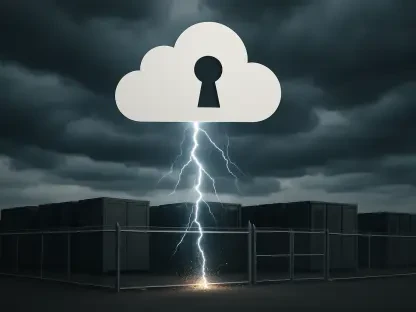In an alarming development that underscores the growing sophistication of state-sponsored cyber threats, a Chinese hacking group known as Salt Typhoon has emerged as a significant danger to global security, targeting critical infrastructure across more than 80 countries. This group, linked to entities supporting China’s Ministry of State Security and People’s Liberation Army, has orchestrated a sprawling cyber-espionage campaign affecting at least 60 organizations. Unlike typical cybercrime driven by financial motives, their focus is on surveillance and data theft, infiltrating sectors ranging from telecommunications to government and healthcare. The scale of this operation, as highlighted by recent advisories, reveals a persistent and stealthy adversary capable of lingering undetected within compromised systems for extended periods, posing a severe challenge to international cybersecurity efforts.
Understanding the Scope of the Threat
Unpacking the Scale of Attacks
Salt Typhoon’s operations have cast a wide net, impacting a diverse array of sectors with a particular emphasis on telecommunications providers. Their strategy involves targeting critical network components such as backbone routers, provider edge, and customer edge routers, which are pivotal to global communication networks. Beyond telecoms, the group has infiltrated government and military systems, as well as healthcare organizations, aiming to extract sensitive information that could undermine national security and privacy norms. A striking instance of their reach was the breach of a U.S. state National Guard network, where they maintained access for nearly a year, siphoning off crucial military and law enforcement data. This incident alone underscores the audacity and persistence of their espionage efforts, revealing a threat that transcends borders and demands a coordinated global response to safeguard vital infrastructure from such invasive tactics.
Global Reach and Sectoral Impact
The breadth of Salt Typhoon’s campaign is staggering, with documented attacks spanning over 80 countries and affecting a multitude of critical sectors. This indiscriminate targeting highlights a calculated intent to disrupt not just individual organizations but entire systems of communication and governance worldwide. In healthcare, for instance, the indirect consequences of their actions could jeopardize patient data and disrupt essential services, as warned by cybersecurity experts. The group’s ability to exploit interconnected networks means that a breach in one sector can ripple through others, amplifying the potential damage. Government agencies, often seen as fortified against such threats, have not been spared, with sensitive data becoming a prime target for espionage. This pervasive threat necessitates a reevaluation of defensive strategies across industries, emphasizing the urgency of identifying vulnerabilities before they are exploited by such sophisticated adversaries.
Strategies and Responses to Counter the Danger
Tactics Employed by the Adversary
Delving into the methods of Salt Typhoon reveals a highly sophisticated approach to cyber-espionage that leverages both technical prowess and strategic patience. The group exploits known vulnerabilities in networking equipment, manipulates access control lists, and establishes privileged accounts to ensure long-term access to compromised systems. Their ability to enable remote management capabilities further entrenches their presence, making detection incredibly challenging. Once embedded, they navigate through trusted connections to infiltrate adjacent networks, expanding their reach while remaining under the radar. This stealthy persistence was evident in several high-profile breaches where their presence went unnoticed for months, allowing extensive data exfiltration. Such tactics highlight the need for continuous monitoring and advanced threat detection mechanisms to identify and neutralize these intrusions before they cause irreparable harm to critical systems.
Collaborative Defense and Mitigation Efforts
In response to this escalating threat, the FBI, alongside the Cybersecurity and Infrastructure Security Agency (CISA), has issued detailed guidance to help organizations detect and mitigate potential intrusions. Emphasis has been placed on the importance of international collaboration, as the scale of Salt Typhoon’s operations requires a unified front to counter Beijing’s aggressive cyber strategies. Practical steps include bolstering network security protocols, promptly reporting suspected activities to local FBI field offices, and sharing intelligence across borders to track and disrupt the group’s activities. Experts also advocate for aggressive action in sectors like healthcare, where identifying and containing related malware is critical to protecting sensitive data. These collective efforts aim to fortify defenses against a threat that seeks to undermine global privacy and security norms, urging all stakeholders to remain vigilant and proactive in safeguarding their digital environments.
Building a Resilient Future
Reflecting on the extensive campaign orchestrated by Salt Typhoon, it became evident that the cybersecurity landscape had faced one of its most formidable challenges with this state-sponsored threat. The persistent and stealthy nature of their attacks, which spanned telecommunications, government, and healthcare sectors, had demanded an unprecedented level of vigilance and cooperation among affected nations. Looking ahead, the focus shifted to actionable strategies, such as enhancing public-private partnerships to share threat intelligence and investing in cutting-edge technologies to predict and prevent future intrusions. Governments and organizations were encouraged to prioritize regular security audits and employee training to close gaps that adversaries might exploit. As the digital realm continues to evolve, fostering a culture of resilience and readiness remains paramount to staying ahead of such sophisticated cyber threats, ensuring that the lessons learned from past breaches pave the way for a more secure global infrastructure.









